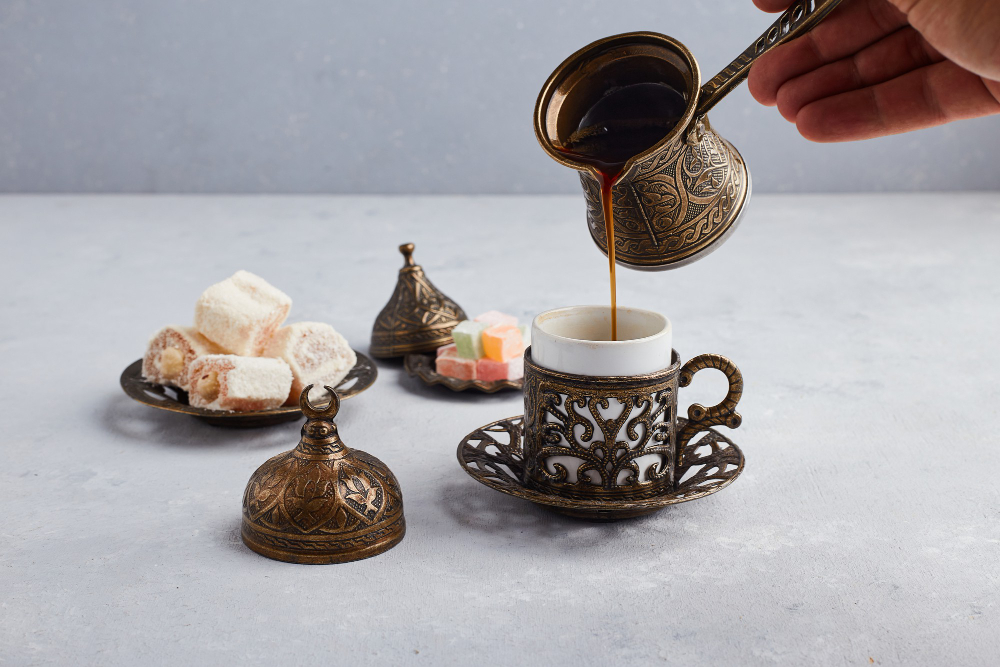Turkish coffee, often referred to as “Türk kahvesi,” is more than just a beverage; it’s a centuries-old tradition deeply embedded in the culture and history of Turkey and the surrounding regions. This rich, aromatic brew has captivated coffee enthusiasts worldwide with its unique preparation method and the sense of community it fosters. In this article, we will explore the fascinating ritual of Turkish coffee, delving into its brewing process, historical significance, and cultural relevance.

Brewing the Perfect Turkish Coffee
Ingredients and Equipment
To create an authentic Turkish coffee experience, you’ll need the following ingredients and equipment:
Coffee Beans
Turkish coffee begins with the selection of high-quality, finely ground coffee beans. Arabica beans are preferred for their rich flavor and aroma.
Water
Fresh, cold water is essential for brewing Turkish coffee. Use a clean, cold water source to ensure the best taste.
Sugar
While sugar is optional, it’s a common addition to Turkish coffee. Adjust the sweetness to your preference.
Cezve
A cezve, a small long-handled pot, is traditionally used to brew coffee. It allows precise control over the brewing process.
The Brewing Process
Brewing Turkish coffee is an art that requires patience and precision. Follow these steps for a perfect cup:
Measure
Measure the coffee grounds, water, and sugar according to your desired cup size. Typically, one heaping teaspoon of coffee per ounce of water is a good starting point.
Mix
Combine coffee, sugar, and cold water in the cezve. Stir gently to dissolve the coffee and sugar.
Heat
Place the cezve over low heat, allowing the coffee to slowly heat up. Avoid stirring during this phase.
Froth
As the coffee heats, a frothy layer, known as “kaimaki,” will form. When it’s about to boil, remove the cezve from heat to prevent spillover.
Serve
Pour the coffee into a small cup, ensuring that each serving includes a bit of kaimaki. Allow it to settle for a moment before sipping.

A Glimpse into Turkish Coffee’s History
Origins
The history of Turkish coffee can be traced back to the 15th century when coffee beans were first introduced to the Ottoman Empire. The brewing method and culture surrounding it quickly became an integral part of Turkish society.
Coffeehouses
During the Ottoman era, coffeehouses, known as “kıraathane,” became bustling centers of social interaction. These establishments were places where people from all walks of life gathered to discuss politics, literature, and current events over cups of rich, dark coffee.
The Cultural Significance
Fortune Telling
A unique aspect of Turkish coffee culture is the art of fortune telling, or “tasseography,” using coffee grounds left at the bottom of the cup. This ancient practice adds an element of mystique to the coffee ritual.
Pairing with Desserts
Paiting turkish coffee with some desserts such as Baklava, which is a sweet pastry made with layers of filo dough and honey, it is most liked choice.
Serving in Small Cups
Turkish coffee is traditionally served to the people in small cups, which is often called as “fincan.” The small cup size is deliberate, allowing the grounds to settle at the bottom. When enjoying Turkish coffee, sipping slowly and savoring each sip is essential to fully appreciate its flavor and cultural significance.
Conclusion
It is more than just a drink; it’s a bridge between the past and present, a symbol of Turkish hospitality, and a source of cultural pride. As you sip this rich and flavorful brew, you partake in a centuries-old tradition that has endured the test of time. The next time you savor a cup of Turkish coffee, take a moment to appreciate the history, culture, and camaraderie it embodies.
To know more about me follow on Instagram
